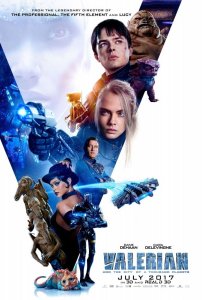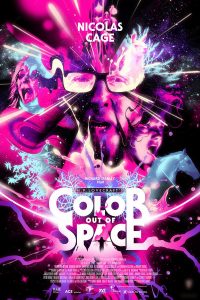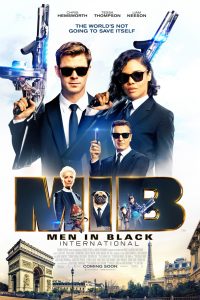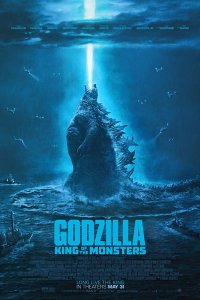“This Is Going to Be a Lot of Fun”: A Review of Valerian and the City of a Thousand Planets
 For the most part, I found Luc Besson’s Valerian and the City of a Thousand Planets to be an enjoyable space adventure, deploying consistently dazzling visuals in support of an involving story that never becomes entirely predictable. And while serious issues are intermittently raised, the film is refreshingly unpretentious, in contrast to other recent films, as the director’s primary aim was clearly to entertain audiences, not to enlighten or inspire them with portentous bromides. Its aim, then, is well conveyed by Valerian’s statement upon reaching space station Alpha, “This is going to be a lot of fun.” Appealingly childlike – though not childish – the film invites comparison to other colorful classics like The Wizard of Oz (1939) and the film that it most visibly seeks to emulate, the original Star Wars (1977).
For the most part, I found Luc Besson’s Valerian and the City of a Thousand Planets to be an enjoyable space adventure, deploying consistently dazzling visuals in support of an involving story that never becomes entirely predictable. And while serious issues are intermittently raised, the film is refreshingly unpretentious, in contrast to other recent films, as the director’s primary aim was clearly to entertain audiences, not to enlighten or inspire them with portentous bromides. Its aim, then, is well conveyed by Valerian’s statement upon reaching space station Alpha, “This is going to be a lot of fun.” Appealingly childlike – though not childish – the film invites comparison to other colorful classics like The Wizard of Oz (1939) and the film that it most visibly seeks to emulate, the original Star Wars (1977).
In one interesting respect, however, Besson defies the pattern set by George Lucas, since the first line of his space epic – “A long time ago, in a galaxy far, far away” – defiantly refuses to connect its story’s events to any aspects of Earth’s history. Yet this film’s opening sequence painstakingly establishes its setting as an outgrowth of humanity’s past and anticipated future achievements in space travel: we first observe actual footage of the 1975 meeting of American and Soviet astronauts during the Apollo-Soyuz mission, followed by a series of future meetings on Earth-orbiting space stations, first involving several groups of people from different nations (in 2020 and 2031), then involving humans, exotic aliens, and robots (in 2150). At this point, we are told that the now-enormous Alpha has become a menace to Earth, so it is dispatched on a long interstellar journey to the “Magellan Current” and becomes, 400 years later, the bustling home of innumerable alien species inhabiting four separate environments. Besson insists, in other words, that his extravagant vision actually represents one possible future for the human race – and also explains some seemingly anachronistic features of his world, like the “Ivy League education” of Valerian’s partner Laureline (Cara Delevingne) and use of the familiar three-pronged symbol to warn of radioactivity. Of course, no “Magellan Current” exists; we are told that the length of the station’s journey was “700 million miles,” which would leave it within the solar system, though it is obviously supposed to be many light years from Earth; and one struggles to imagine how to propel a city-sized object so that it would reach such a distance in 400 years. But like other science fiction filmmakers, Besson employed no scientific advisors to address these practical issues, and while they have no impact on the overall quality of the film, these lapses do undermine an apparently sincere effort to make his story seem scientifically plausible.
Knowingly or not, Besson is also joining a long tradition of science fiction stories about space stations, which I have explored in two books. The name of his station, Alpha, has been employed in numerous science fiction stories (most prominently in Ben Bova’s Kinsman series), and there are also several stories about transforming space stations into traveling spaceships (though the usual motive is escaping the monotony of endlessly orbiting Earth, not saving the planet from an impending catastrophe). But Besson most aligns himself with earlier science fiction because of his realization, as I said in Islands in the Sky: The Space Station Theme in Science Fiction Literature (1996), that “A space station would be an ideal place for humans and aliens to meet – neutral ground, as it were,” and an environment “where traditional enemies can meet without animosity or hostility” – concepts most prominently aired in the television series Babylon 5 (1994-1999). Given that both people and posited aliens are deeply tied to the places where they live, and will always have an advantage in their home environment, a space station might indeed represent the only place where disparate individuals could interact as equals, as already observed in the cooperative efforts of many nations to construct and staff the International Space Station. And Besson repeatedly emphasizes that tremendous progress has occurred because the disparate species inhabiting Alpha have been able to share their knowledge and ideas. Despite its fanciful story, then, Valerian has embedded in it the real-world argument that we need to maintain and eventually replace the ISS as a mechanism for improving international relations and achieving scientific advances.
To underline these points, Besson has assembled a reasonably diverse cast, and no one seems to dislike, or discriminate against, the various odd-looking aliens that are constantly in view; prejudice is displayed solely by one alien race that excludes other beings from their enclave with guards and a sign reading “No Forigners Allowed” (the spelling error suggesting that bigots aren’t too bright). If one ethnic group is slightly favored, it is the Chinese, reflecting how important they have become to a film’s financial success. Thus, the first fictional group of greeted space visitors is Chinese; one briefly glimpses a Chinese flag in space station Alpha; one assistant to General Okto-Bar (Sam Spruell), an unnamed female sergeant, is portrayed by a French-British actress of Asian descent, Claire Tran; and a noted Chinese singer who has had several hits, Kris Wu, is cast as Sergeant Neva, Okto-Bar’s chief aide. (Could this film’s “Exo-Space” be a reference to Wu’s old band, EXO?) And Neva, who originally functions as a spear carrier, actually emerges as a major hero in the final scenes, inasmuch as his actions, not Valerian’s, ultimately save the day.
Since my familiarity with Pierre Christin and Jean-Claude Mézières’s graphic novel series “Valerian and Laureline” is limited to the four stories included in the recently published Valerian: The Complete Collection Volume 1 (2016), it is possible that space station Alpha, and other aspects of Besson’s story, first appeared in one of their stories; and Besson does include one of the series’ recurring aliens, three greedy but informative Shingouz. I suspect, though, that this film’s plot is largely original, though vaguely inspired by the similarly titled “The Empire of a Thousand Planets” (1971). Both stories begin with Valerian and Laureline assigned to surreptitiously visit a planet with a large marketplace, though their mission here is not to investigate the planet, but rather to obtain a valuable object. And the appearance of Christin and Mézières’s planet Syrte – crowded streets filled with variegated and sometimes suspicious aliens – probably influenced Besson’s “Big Market” on the planet Kyrian and Alpha’s urban centers.
There are also several films that had an impact on Besson’s story. One idea is lifted from the Star Trek universe, as its most prominent aliens share the Vulcan ability to transfer one’s consciousness to another person’s brain at the time of death. When Valerian ventures into Alpha’s “Paradise Alley,” filled with garish illuminated signs and aggressive prostitutes, some might recall the dark, seedy streets of Ridley Scott’s Blade Runner (1982) – perhaps referenced by Besson’s use of one of its stars, Rutger Hauer, who briefly appears as the President of the World State Federation; there are also resonances with the urban landscapes of Besson’s own The Fifth Element (1995). But viewers will be most aware of the film’s references to the Star Wars films, including a villain who looks suspiciously like Jabba the Hutt, a scene wherein Valerian (Dane DeHaan) and Laureline escape by falling into a chamber filled with garbage, and Laureline’s comment, “I have a bad feeling about this idea.”
Most disheartening, though, are Besson’s overt borrowings from James Cameron’s Avatar (2009 – review here). The tall, thin aliens of the planet Mül, termed Pearls, with their light blue skins and loincloths, visibly resemble Cameron’s Na’vi, and they are also described as peaceful people who “lived in harmony with the planet.” Like the Na’vi, they are also oppressed by human soldiers with a crazed, fanatical leader – Commander Filitt (Clive Owen) – who is determined to “Annihilate” the “savages” who are interfering with his plans. Yet Besson improves upon Cameron in several respects. For one thing, this apparently simplistic melodrama is only one major thread in a complex plot featuring other humans and aliens who are harder to classify as heroes or villains, and the story itself is more nuanced, as Filitt articulates a rational motive for his actions – a desire to save humanity from financial ruin – and he is ultimately opposed by his calm, compassionate subordinate Okto-Bar, contradicting the stereotype of the evil, genocidal soldier. The Pearls are developed more creatively than Cameron’s blue-skinned Native Americans: their faces are illuminated by colored dots to show emotions, they employ their planet’s actual pearls to obtain energy, and these and other gems can be endlessly duplicated by their cute reptilian pets, the Converters. They also respond to changed circumstances by embracing advanced technology, teaching themselves “mathematics, chemistry, physics, and philosophy” to survive, and invent and use energy weapons in an attempt to reacquire one of their Converters – so the story does not devolve into a trite fable about virtuous nature corrupted by sinister science.
I am not sure why I initially compared this film to The Wizard of Oz, since there are no obvious connections or references to the earlier film; probably, I simply regarded them both as charming stories about young people traveling through marvelous lands. Yet there are a few similarities to pursue. Both are stories focused on returning home: Valerian regularly expresses a strong desire to finish his mission, go on “vacation,” and marry Laureline to achieve some domesticity in his life, while the Pearls fervently hope to re-create and re-inhabit their lost idyllic world. The travelers here, like Dorothy, are sometimes accompanied and assisted by strange companions – the Converter, the Shingouz, the shapeshifting Bubble (Rihanna), and the eccentric submariner Bob (Alain Chabat). And both protagonists discover that nothing in the exotic realms they enter is as it seems: the commander Valerian and Laureline are assigned to assist turns out to be a villain, and the dangerous “radioactive zone” they are instructed to avoid is harmless.
Most significantly, the films can be linked because both sets of filmmakers were manifestly determined to fill their films with bright colors and amazing special effects, so that even if audiences aren’t closely following the plot, the screen is always offering something to entertain them. And Besson and his associates are profligate in providing a constant stream of wonders, so much so that one cannot possibly absorb them all in a single viewing. During Valerian’s visit to the Big Market, for example, one observes a floating Eiffel Tower, a jellyfish-like creature hovering in a street, and an alien resembling a turkey – but each is only visible for a second, and there were several dozen other structures and beings that I barely noticed at all. Further, there are definite signs of intelligence in some of the films’ visual effects. Consider, for example, one recurring cliché in the increasingly common, Blade Runner-like “retrofuture” I discussed while reviewing Ghost in the Shell (2017 – review here): crowded city streets with advertising holograms. These are usually placed above or to the side of the streets, and they make no sounds, so that pedestrians can easily ignore them. The holograms in this film materialize directly in front of Valerian and talk to him, virtually requiring him to pay attention; so, when one asks, “Hey, you need a lawyer?” Valerian replies no, he’s a government agent. And that’s the sort of holographic advertising that marketers would logically prefer.
While Valerian is thus a visual feast, it is not a film that one would want to listen to. There is nothing really memorable about Alexandre Desplat’s soundtrack, and the film’s song choices are uninspired. With so many songs about astronauts available, it is disappointing that Besson, for what seems like the thousandth time, turns to David Bowie’s “Space Oddity” (1969); when using a more memorable song, Bob Marley and the Wailers’ “Jamming” (1977), Besson should play more than a snippet of it; and one fervently hopes that people in the twenty-sixth century will find better music to dance to than Wyclef Jean’s 1997 rap version of the Bee Gees’ “Stayin’ Alive” (1977). Interestingly, when a female tourist (Irene Palko) purchases a French horn at the Big Market, her husband (Sam Douglas) comments that she doesn’t even know what it’s for – perhaps suggesting that people in the future have no taste in music.
But the film’s major musical sin involves two of its stars, pop singer Rihanna and jazz keyboardist Herbie Hancock. With such talents available, Besson should have sent them to the studio to work up some great music to perform in the film and improve its soundtrack. (Perhaps singer Wu could also have been invited to join the jam session.) Yet Rihanna never sings, and Hancock, playing the future’s Defense Minister, is limited to terse, televised messages. More broadly, Rihanna’s scenes represent a major weakness of the film. The dance she performs for Valerian, instantly changing her costume again and again, contributes nothing to the story, goes on much too long, and, considering the film’s other stunning visuals, isn’t particularly impressive; but when someone casts a star, I suppose, they must give her a star turn. In addition, unlike all of the other characters, Rihanna’s Bubbles keeps dispensing trite advice and empty platitudes: “show some weakness – it will make her feel important”; “take good care of her – love her without measure”; “where I come from, life is more painful than death”; “life’s a drag when you don’t have an identity to call your own.” Finally, she is written out of the story abruptly and unpersuasively, as if Besson recognized her character was an intrusive embarrassment that needed to be excised as quickly as possible.
Although I have read no other reviews of Valerian, glances at links indicate that a lot of critics didn’t like this film, and I’m struggling to figure out why. Perhaps the real problem is that, as I have been intimating, Valerian is at its heart a children’s film, based on some old comic books that entranced a young Luc Besson, and it should be evaluated within that context. And while the 31-year-old DeHaan and the 25-year-old Delevingne are fine in their roles, Besson might have been better advised to skip a generation, cast teenagers as his leads, and recast his story as Valerian’s very first adventure – to convey and underline the youthful spirit that animates his story. So, if you want some adult entertainment this weekend, go see Dunkirk, but I don’t regret that I chose to watch this film instead.
–Gary Westfahl
Gary Westfahl has published 25 books about science fiction and fantasy, including Science Fiction Quotations: From the Inner Mind to the Outer Limits (2005), The Spacesuit Film: A History, 1918-1969 (2012), A Sense-of-Wonderful Century: Explorations of Science Fiction and Fantasy Films (2012); excerpts from these and his other books are available at his World of Westfahl website. He has also published hundreds of articles, reviews, and contributions to reference books. His most recent books are the three-volume A Day in a Working Life: 300 Trades and Professions through History (2015) and An Alien Abroad: Science Fiction Columns from Interzone (2016), now available from Wildside Press; ; his forthcoming books include Arthur C. Clarke and a collection of essays from the Eaton Conferences on Science Fiction and Fantasy Literature.







Luc Besson is not a French film director like Jean-Luc Godard or François Truffau (many others)… La Femme Nikita (1990) was like no French action film I had ever seen. However I was disappointed in Valerian and the City of a Thousand Planets. I was not all that taken by Besson’s Fifth Element tho I like it better.
Jean-Claude Forest created the character of Barbarella 1962 , and Pierre Christin and artist Jean-Claude Mézières made Valérian, Agent Spatio-temporel ,1967. I read copies of these in the 1960’s. My reaction then was “this looks like johnny-come-lately Flash Gordon with a continental whiff of detachment”. Many European space operas , especially the comic book kind, seem to be trailing works done in America and Great Britain , I am not sure why. Though solid comic book space opera vanished from comics in the late 1950s, it had had a come back in modern times. I am afraid Besson’s nostalgia form this comic from his youth is misplaced.
I thought the film had a good start , until they got to Alpha and all the narrative goes away. Becomes overstuffed and shades towards a doggy juvenile pulp style. I was never over enthusiastic about Star Wars , but does Bresson notice that Star Wars ‘shadows’ modern American and British space opera as it evolved in the 1940s and 1950’s? (Alas Star Wars has not advanced beyond that. Much less use the more sophisticated SF source material from the 1950s onward.) Yes this is too much a children’s comic book film, I put that away a long time ago when it no longer drew me in and entertained me.
Gary Westfahl,
My 5th viewing of Valerian held up well — and your review was pitch perfect. Now I have to read your other reviews. I see what you’re doing here.
Edg Duveyoung